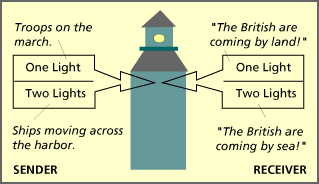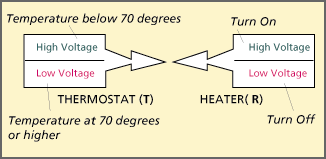
 TUTORIAL: THE COMMUNICATION PROCESS
TUTORIAL: THE COMMUNICATION PROCESSINTRODUCTION . SYSTEMS . THE ROLE OF COMMUNICATION . HUMAN AND NON-HUMAN COMMUNICATION . THE SHANNON/WEAVER MODEL OF COMMUNICATION . CONTENT AND CODE .
The simple version of the Shannon/Weaver model of communication assumes that the signal leaves the transmitter, travels down a single channel, and arrives at the receiver. But that is not always the case.
For example, although human speech is communicated by means of sound signals in air, we often speak over the telephone - an electronic device the provides us with a "non-air" channel. Consider this in more detail.
When a telephone is in use, the speech of the speaker must be changed from sound signals to electrical signals prior to being transmitted through the telephone system, and then changed back from electricity to sound at the other end before delivery to the listener. A number of questions come to mind regarding this process; including:
These, and similar questions, lead into some of the more complicated and interesting areas of communication studies. Of course these questions will not be answered in full detail in these tutorials, but the thread of this discussion will reappear from time to time in the sections that follow.
First, consider the concepts of content and code. The content of a signal is its meaning or significance to the transmitter and/or the receiver. A code is a process that is able to change one set of signals into another and back again with no change in content.
To say that a message has content is to shift the focus of study from the signal itself to the initial act by which the transmitter creates the signal, and the following act by which the receiver interprets it. Clearly, the transmitter selected this particular signal from all of the possible signals that might have been sent, and just as clearly, the receiver attaches some significance to the arrival of this particular signal instead of some other.
Thus, the meaning of the signal lies not only in its composition, but in its relationship to other possible signals that could have been sent and received.
As an example, consider the situation described in Henry Longfellow's well-known poem, Paul Revere's Ride:
He said to his friend, "If the British march
By land or sea from the town to-night,
Hang a lantern aloft in the belfry arch
Of the North Church tower as a signal light, -
One, if by land, and two, if by sea;
And I on the opposite shore will be,
Ready to ride and spread the alarm..."
In the situation described in the poem, the medium is light and the
signal is to be either one beam of light or two. The content of the message
will refer to the action of British troops near Boston, and the transmitter will choose to send a signal of one light or two based on the path the
troops are taking. The receiver will interpret one light as
indicating a march by land and two as indicating an advance by boat. The next
picture illustrates how the signal becomes meaningful to the two
communicators.
![]() 9015
9015

Another illustration of the content of a signal can be seen in the standard
household heating system. Here the medium is electricity and the signal is a
high or low level of voltage. When the sensor in the
thermostat records a temperature below a certain setting (in case of the
example illustrated in the next picture, 70 degrees Fahrenheit), it changes the
voltage signal from low to high. When the heater receives a high voltage, it
turns itself on. If the temperature then rises to 70 degrees or above, the
sensor in the thermostat sends a low voltage, and as soon as the low signal is
received by the heater, it turns itself off. Thus, the incoming signal from
the thermostat has significance to the heater.
![]() 9016
9016
![]() 9017
9017
![]() 9018
9018

In each of these examples, the selection of a particular signal to be sent by the transmitter and the interpretation of a signal acquired by the receiver involved the use of a code. In each case the first signal was changed into another kind of signal in such a way that it could be changed back again with no change in meaning.
In Paul Revere's Ride the words "by land" and "by sea" were changed by the transmitter into the visual image of one light or two - and then they were changed back again by the receiver.
The thermostat/heater code works in a similar way as is discussed in more detail in this example: ![]() Extended Thermostat Example.
Extended Thermostat Example.
The notion of coding signals to preserve meaning in messages as they change media, is central to the study of human communication, and particularly in the study of language and culture, two subjects that will be introducted in later sections of this tutorial.
![]() 9020
9020
![]() 9021
9021